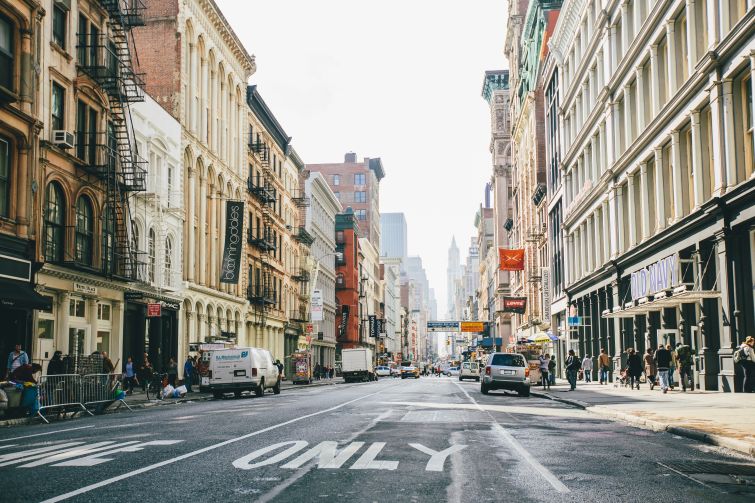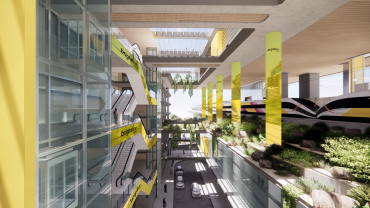A Possible Rezoning Raises Questions About the Future of Soho
By Rebecca Baird-Remba October 22, 2019 1:00 pm
reprints
Soho and Noho are, in many ways, frozen in time. Retailers change, but the beautiful, landmarked, cast-iron and brick buildings remain the same.
However, as the city examines the neighborhood’s outdated zoning, it has opened up the possibility of legalizing residential and retail uses that have existed in the area for decades and paving the way for new development. It could radically alter Soho and Noho, which have some of the highest residential and retail rents in the city.
Both neighborhoods are heavily landmarked, making it hard to redevelop buildings and empty lots. But a new study by the Department of City Planning aims to change the current manufacturing zoning, which creates a stumbling block for landlords and has stymied development in the area since the 1970s. (Soho and Noho are zoned M1-5A and M1-5B, a designation that makes both apartments and stores illegal without a special permit.)
DCP hasn’t announced a specific release date for the study, but it does plan to present its findings and recommendations to Manhattan Community Board 2 on November 20.
Commercial property owners argue that they simply want to be able to rent out their retail space without having to go through an onerous special permit process that can take years to complete. They place some of the blame for Soho’s high retail vacancy rates on the restrictive land-use rules, which make it harder for landlords to fill empty ground-floor space.
“As we all know, Soho is primarily ground-floor retail and there’s a significant amount of residential,” said GFP Real Estate’s Brian Steinwurtzel, who belongs to a pro-rezoning group called the Fix Soho/Noho Coalition. “Clearly, the zoning doesn’t match what’s actually there.”
GFP owns two large commercial buildings in the neighborhood, including Dean & DeLuca’s newly shuttered flagship at 560 Broadway. The company hasn’t had to go through the special permit process because 560 Broadway has a grandfathered certificate of occupancy, meaning retail use on the ground floor predates the creation of the current 1960s zoning code.
The current rules also cap retail stores at 10,000 square feet without a special permit and forbid chain retailers from occupying the upper floors of a building. The Soho Nike store, for example, sprawls across six floors, and it’s legal because the shoe brand’s lawyers applied to split the space into six separate stores, each with their own cashier. Similarly, Zara has just applied to legalize its 4-year-old flagship at 503 Broadway, which spans 46,361 square feet and illegally occupies the second floor of an industrial building.
The special permit process can take up to two years and cost owners tens of thousands of dollars, most of which goes toward land-use lawyers and real estate consultants. A landlord must advertise in a local newspaper for several months to find a tenant that fits the allowed manufacturing uses. Then if it can’t get an industrial tenant, it must get approvals for a retail store from the local community board and the City Council.
“We all know there aren’t light manufacturers that are going to rent space in the district,” said Steinurtzel. “So why force someone to go through this special permit process that costs a lot of money and takes a lot of time when the use that the neighborhood wants is retail?”
Soho already has 3 million square feet of retail, and some argue it has oversaturated the neighborhood. The popular shopping hub has so much high-priced retail that many landlords struggle to fill empty stores, dragging down asking rents along Broadway between Houston and Canal Streets. City planners hope to encourage a broader range of ground floor uses, which could help prop up the area’s lagging retail market. During a June presentation on the zoning study, a planner hired by the city said it wants to allow community facilities, food stores and arts and cultural uses.
Meanwhile, neighbors who oppose a potential rezoning feel that Soho has too many large stores that exceed the 10,000-square-foot cap.
“We’re extremely conscious of the fact that there’s a glut of oversized retail space in the neighborhood already, much of it illegal,” said Andrew Berman, who heads the Greenwich Village Society for Historic Preservation. He helped organize the Soho/Noho Coalition, a collection of groups that oppose major zoning changes in the area.
Locals claim that larger retail stores not only violate the zoning rules but lead to disruptions like late-night deliveries and shops leaving their lights on all night. In June, the city said it hopes to address those quality-of-life issues by regulating parking and trash pickup and better enforcing existing laws. A large chunk of Soho’s retail is illegal, but it has proliferated because the city has turned a blind eye to zoning rules. City officials concerned with tax revenue have preferred to keep the area full of shoppers and tourists rather than force landlords to follow zoning and building codes.
“The current situation is a mess and it’s an unfair one,” Berman explained. “Some people have made a killing off of it and still others have suffered. And the reason it exists is because the city has unfairly and unevenly enforced the rules.” He added that he and his coalition partners “would be open to a rationalizing of the system that’s fair to everybody and does allow a certain amount of retail.”
Of course, some people have more ambitious goals than legalizing retail. Will Thomas, an East Village resident and member of pro-development group Open New York, thinks the city’s study provides a perfect opportunity to create new housing. A residential upzoning would be a radical proposal for an affluent neighborhood where few buildings rise higher than a dozen stories. In some areas, Open New York hopes to up the allowed residential density to as much as 12 FAR (floor area ratio). If the area were rezoned for mid- or high-rise residential development, Thomas argues, new apartment buildings would have to include affordable housing, which is required by the city’s mandatory inclusionary housing (MIH) program.
“When it came to the city putting forth this upzoning in one of the wealthiest neighborhoods in the country, it just rubbed us the wrong way that there was no increase in affordable housing,” Thomas explained. “In fact, no affordable housing has been built in the neighborhood during the de Blasio administration. In that sense, it’s kind of a slap in the face. With those high rents, it’s tailor-made for MIH; the rents are high enough that it could subsidize affordable housing.”
He points out that new residential construction with low-income units could help diversify the area, which is 72 percent white and has a median household income of $113,000. Open New York hopes to forge a coalition with local groups from the East Village, the Lower East Side and Chinatown to push for denser residential zoning in Soho and Noho.
“I think the politics of development are changing,” Thomas explained. “I think gentrifying low-income neighborhoods used to be a lot more open, but now those neighborhoods are fighting back. There’s growing sentiment in those low-income neighborhoods that we need to have a [citywide] plan for growth.”
Meanwhile, current residents of the neighborhood are concerned about legalizing apartments and live-work spaces, which range from completely illegal to the narrow category of “joint live-work quarters for artists.” JLWQA was a classification created in the 1970s to accommodate artists who were moving into what were then derelict manufacturing buildings in Soho. These units can only be occupied by “certified artists,” who have to go through a registration process with the city Department of Cultural Affairs. City officials hope to create a process for non-artist residents to legally occupy such apartments. They also want to create a framework for other kinds of makers and manufacturers to purchase the live-work units.
“You can only get a straight residential use when your building from the ground up on vacant land,” explained Margaret Baisley, a real estate lawyer and 40-year resident of Soho who has pushed for the rezoning. “Conversion of existing buildings only happens as joint live-work quarters.”
Baisley said she supported additional subsidies to keep artists in the neighborhood and setting aside vacant ground-floor spaces for artists.
“We’re not trying to throw artists out. Forty years ago, the law was changed for them, when all of these buildings were vacant in the 1970s. Why can’t the city make the same consideration for those of us that are living here now?”


